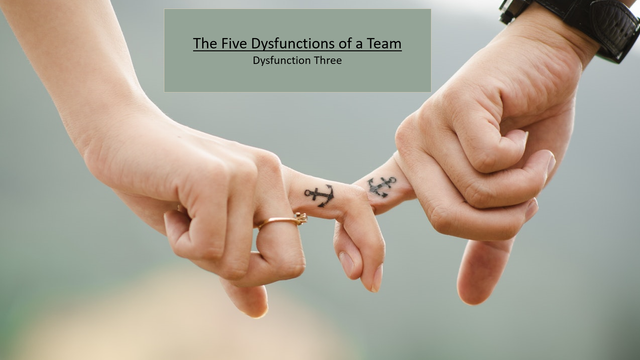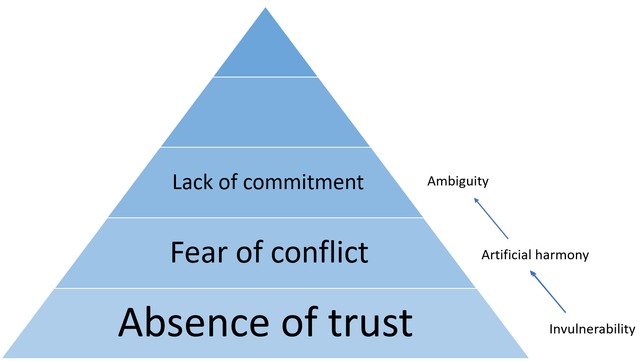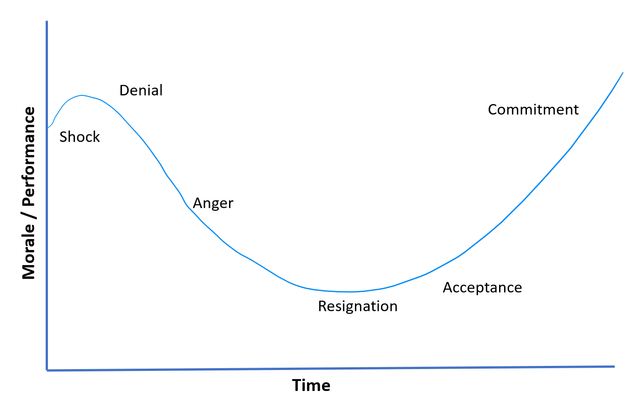The 5 Dysfunctions of a Team: Dysfunction Three

The 5 Dysfunctions of a Team is a book written by Patrick Lencioni. It is written as a fable about a CEO that joins to rebuild a team of executives in a company that is struggling in a competitive market place. It describes, as a leader, how she goes about building a highly functional team by using the 5 dysfunctions of a team model.
I have previously started writing about the 5 dysfunctions, see my post:
We have learnt so far, in the above posts, that the foundation to build a functional team is to establish trust. We need to feel that we are in an environment where we can talk freely. Without trust, we will not be able to deal with conflict and this leads to dysfunction two. If we can deal with conflict we then have to move on to dysfunction three.
Dysfunction Three: Lack of Commitment
How many times have you been to a meeting, discussed something, agreed to something, only to come back later and find that no one has acted on it? This is a lack of commitment in the team and it is often a result of ambiguity.
When we don't deal with the elephant in the room and discuss the difficult issues we end up with a situation where we haven't quite agreed. This is the ambiguity that causes a lack of commitment. If people can't discuss their views freely they will say, "well, I never agreed to that."

Removing the Lack of Commitment in your Team
It is important to discuss fully the different viewpoints and hear all the arguments and then come to a decision. It doesn't mean you will all agree. It is difficult to find consensus on contentious issues but you need to make sure that all the views are heard and have been listened to. Once though the team have made a decision, you must stick to it.
It is good to debate and to make sure you have explored the different opinions, in a trusted environment, but once done, stick to what has been agreed.
“When we are debating an issue, loyalty means giving me your honest opinion, whether you think I’ll like it or not. Disagreement, at this stage, stimulates me. But once a decision has been made, the debate ends. From that point on, loyalty means executing the decision as if it were your own.”
Colin Powell
When you have people in your team that cannot commit it is because they have a difference of opinion and are perhaps stuck in denial that their opinion hasn't been opted as the favourite. The commitment talked about in this sense, in the 5 Dysfunctions book, is similar to that in organisational change management theory. In change theory, you need to be conscious of the change curve that people go along when they need to change their behaviours to commit to what they at first don't like.

Following the change curve, we see that after the initial shock of the change being communicated - denial sinks in and emotions are high. Emotions slowly seep away as their arguments are listened to and they begin to realise that they are losing the argument and eventually they become resigned to the change and acceptance kicks in. From that point, the positive energy starts increasing and we move towards commitment. This takes time and you need to allow your team, where some are not agreeing with the team decision, to go along this curve to reach commitment on the new decision that they were not comfortable with.
Next Post
In the next post, I will continue this journey on how to build a functional team by removing the dysfunctions. Each dysfunction builds on the previous one with trust being the foundation.
As a follower of @followforupvotes this post has been randomly selected and upvoted! Enjoy your upvote and have a great day!
You are absolutely right, it is important that all team members are heard, nothing better than taking your opinion into account, otherwise we are not talking about a team!
@tipu curate
Upvoted 👌 (Mana: 3/9 - need recharge?)
Lack of commitment in a team constitutes to failure in an enterprise.
If the issue of commitments can be handled correctly in a team, it will result in more productivity.
People don't like to commit if they don't feel that they were part of choosing the direction. Inclusivity helps to drive commitment and you are right @mojubare that it will facilitate higher productivity.
Thanks for your comment.
Dear @awah
Another interesting piece.
Finally I've managed to read your post. I bookmarked it like 2 days ago, to ensure to check it out once I have some free time :)
Indeed. People like to talk a lot. But talk alone is just not enough. One need to find ways of executing his ideas and be persistent and commited with his/hers efforts. It's unfortunatelly not easy to find people, who have those qualities.
Solid read. Upvoted already :)
Enjoy your day,
Piotr